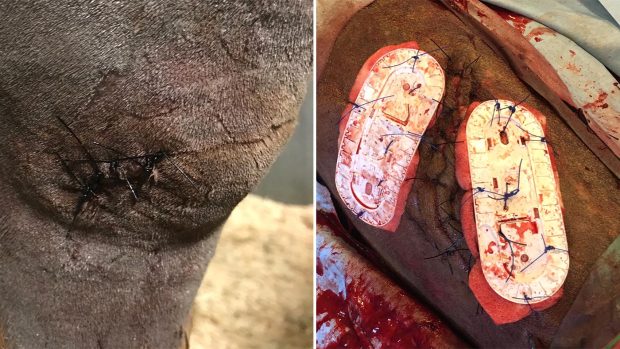All horses have a tendency to damage themselves, often on their limbs and some times their injuries bleed profusely.
The sight of a bleeding horse can be alarming, but it is important not to panic. An average-sized Thoroughbred has to lose 10 to 15 litres of blood before there is a serious problem.
The first thing to do is to assess the type of bleeding:
- Arterial blood will be bright red and will spurt out under pressure from every heartbeat. A common site for this type of injury is the side of the fetlock, where there is a large artery that is easily knocked
- Bleeding from a vein is slower and tends to drip, rather than squirt, from a wound, in a steady flow. The blood is usually dark red or purple in colour
- Bleeding from the small vessels known as capillaries will result in blood oozing from a wound. Usually, this will clot naturally within a few minutes, but applying a cold compress or ice pack can help
Significant blood loss only occurs when bleeding from a large vein or artery is left unchecked. Most small wounds will eventually stop bleeding without interference, as the blood clots, shutting down the damaged vessels.
Stop the bleeding
Any bleeding must be stopped before the wound can be treated. Although a small amount can be beneficial, as it will flush dirt and debris from the cut, but severe bleeding needs to be controlled.
Stem the flow by applying pressure firmly to the wound. Make a pressure pad from thick cloth, or use gamgee with a non-stick dressing underneath. In an emergency, use whatever is to hand, such as a clean T-shirt, large handkerchief or towel. Press the pad against the wound, and hold it there as tightly as possible. It is often easiest to tape it in place.
A thick pressure bandage can be used to control bleeding from wounds on the lower limbs. If the blood soaks through, put extra padding over the top and apply more pressure. You must keep a pressure pad in place for at least five minutes. Don’t be tempted to check it before then, as the bleeding may restart.
An injury involving blood loss is the one occasion when a relatively tight bandage is recommended. A bandage wrapped in several fairly tight turns provides enough pressure to reduce, but not stop, the blood supply to the horse’s lower leg and is also easy to apply in a crisis. A tight dressing should be safe for up to two hours, while awaiting professional help.
In the case of an arterial bleed, pressing the skin firmly a couple of centimetres above the vessel may help to stop the blood flow. This can be done while the first aid kit is fetched. As you apply pressure, compress the area of the wound and also the region just above it, to reduce blood flow towards the wound.
Talk to your horse or pony reassuringly as you do this, encouraging him to stand still, so you can keep the pad in place. If the horse becomes excited, its heart will pump more quickly and blood will run faster. If you keep him calm and still, the blood will clot more easily.
Assessing the horse
It is important to check the horse over for other wounds and to inspect its gums, which should still be a healthy pink colour. If a horse has lost a significant amount of blood, the gums will be pale pink to white and the pulse will be fast. The horse may also look uncomfortable or anxious, or be sweaty and trembling.
Always contact your vet if:
- The horse has lost a large volume of blood
- A wound is bleeding profusely and you cannot stop it
- The horse has not had an anti-tetanus vaccination
- You think the wound may need to be stitched



